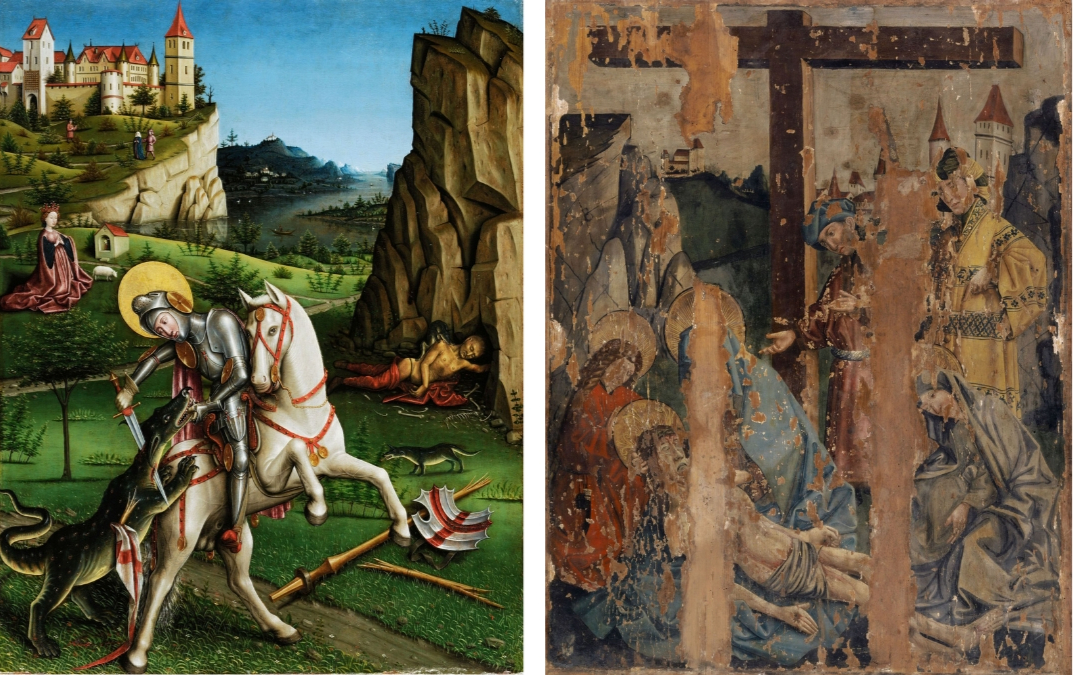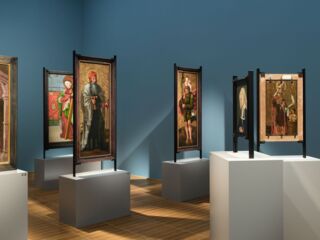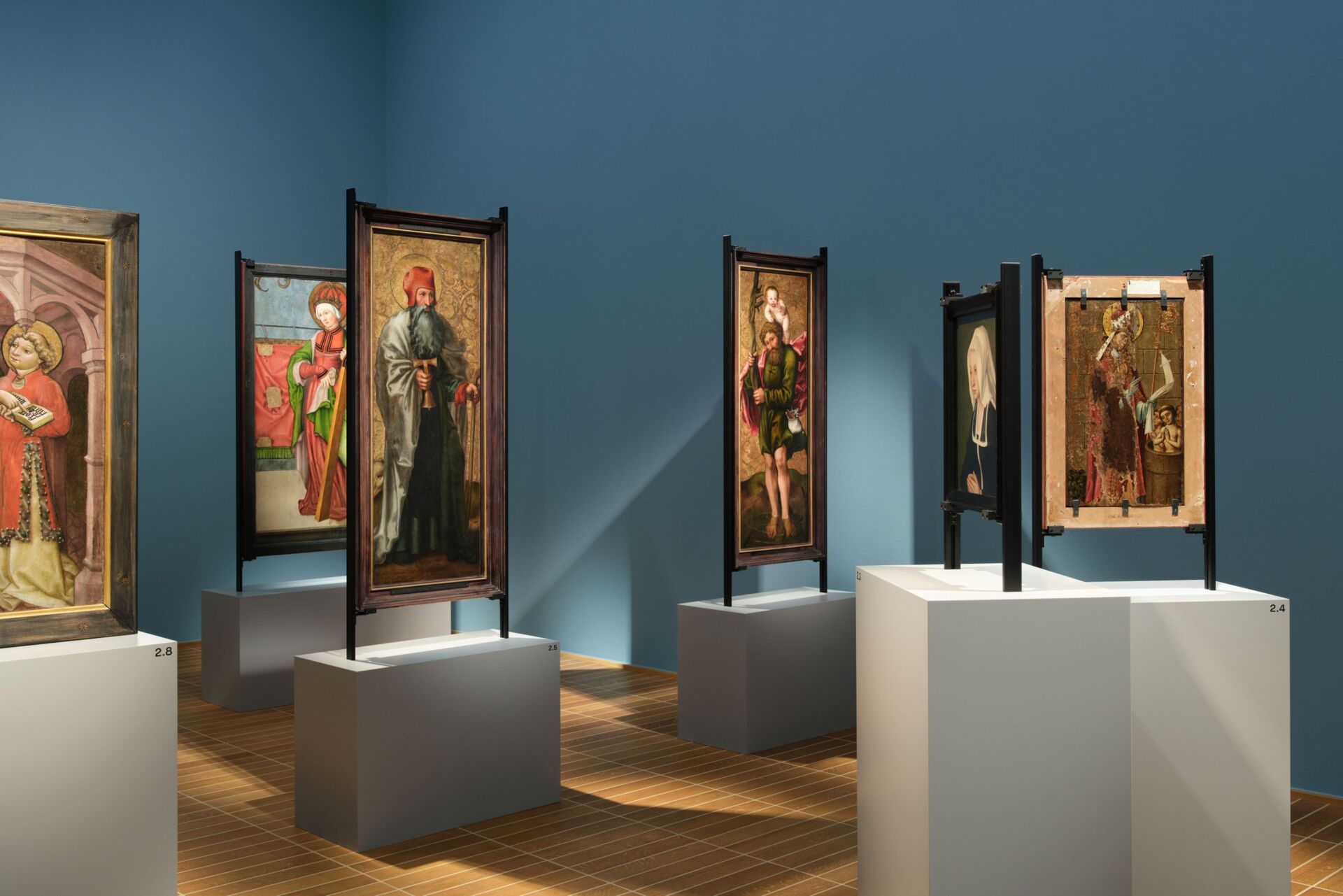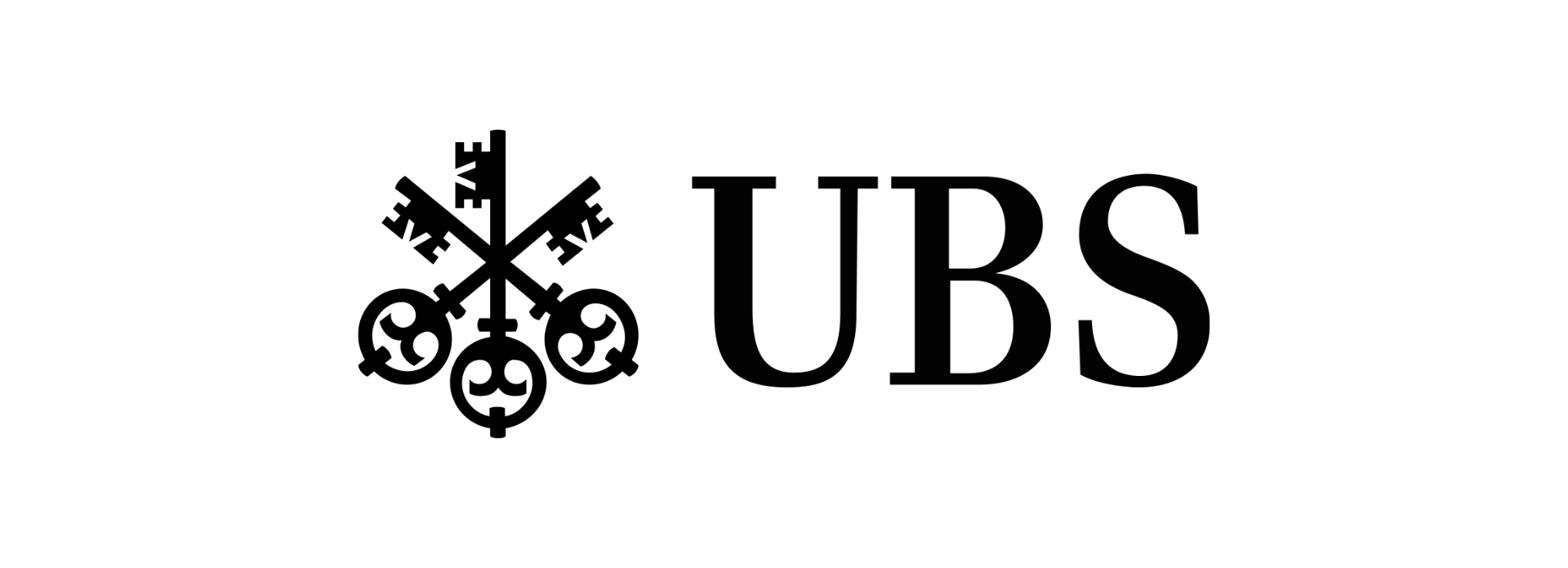Verso
Tales from the Other Side
Have you ever wondered what might be hidden on the back of a painting? In Verso, the flipside of artworks from the 14th to the 18th centuries will be on view, offering a chance to see the concealed sides usually visible only to curators and conservators.
The exhibition shines a light on the lives of artworks before they came to hang on museum walls, showing traces of their circulation in other contexts and their different functions. Find winged altarpieces, painted on both sides so that they could be displayed differently throughout the liturgical year, and coats of arms that were discretely attached to the backside of objects by their owners, or painted panels that had been simply turned over and reused. There’s even a double-sided advertising panel made by Ambrosius and Hans Holbein the Younger as well as paintings specially designed to be picked up and turned over. Verso thus offers new perspectives on artworks, not just by famous names such as Hans Baldung (also known as Grien), Lucas Cranach, and Konrad Witz, but also others that deserve a second look.

Master von Sierentz, The dragon fight of St. George (interior); The Lamentation of Christ under the cross (exterior), Right wing of a retable, around 1445–1450, Kunstmuseum Basel, acquired with funds from the Felix Sarasin Foundation, Photo: Martin P. Bühler
Rooms
The pace of European life, especially in the Middle Ages, was set by the Christian faith. Holy masses, the canonical hours, and the many feasts in honor of saints defined the rhythm of Christians’ daily lives; secular obligations took place in the intervals. Moreover, the faithful were to experience the glory of God and receive guidance from it for a pious life in this world, which would also earn them a place on the good side in the afterlife—the core purpose of any worldly existence. In processions around churches and ritualized gestures performed in unvarying succession and accompanied by chants, the congregation sensed the heavenly power on earth. Since most people in the Middle Ages could not read or write, pictures were a vital means for creating spaces in which the greatness of God could be felt with all the senses.
One essential element of the liturgy celebrated in church were the retables on the altar tables. Starting in the twelfth century, these altarpieces were equipped with lateral wings that could be folded open and shut. They were opened only on high holidays, revealing the middle section—the central object, as it were, of the celebration of the Eucharist. Altarpieces constructed in this fashion were also called triptychs, or, if they had multiple wings on each side, polyptychs. To be aesthetically pleasing both when closed and when open, the wings needed to be decorated on both sides.
Their variable form and uses made altarpieces popular endowments. Given the clergy’s spiritual power and authority in matters of Christian doctrine, they exerted considerable influence also in worldly affairs. People who had money and power did not want to get on the wrong side of them. One way to assure oneself and one’s family of eternal salvation was to endow pictures and liturgical objects for churches. Meanwhile, in making such gifts, donors also secured the favor of ecclesiastical dignitaries and ultimately shored up their secular power.
The facts of an endowment were integrated into the iconographic program in recognizable ways. See, for example, the two altarpieces which have survived in their entirety, whose donors or owners appear in prominent positions: placed in the foreground of the interior wing panels, turned toward the center in prayer, they discreetly take their front-row seats as they join the faithful in worshipping the Lord in the middle panel.
These two completely extant winged altarpieces from the Kunstmuseum’s collection date from the waning years of the Middle Ages. They illustrate the high degree of standardization in the production of such works at the time—their iconographic programs are virtually identical: the Three Wise Men worship the infant Jesus, framed by events that preceded (left) and followed (right) this central scene. During the liturgy, then, the faithful contemplated a major episode of the nativity story. Meanwhile, the same standardization now enables us to reconstruct the likely composition of altarpieces that have survived only in part, as with the two wings that have lost their central panel. Their iconographic program is the same as the one of the altarpiece by the Antwerp Master, and so the missing central panel probably also depicted the Adoration of the Magi.
The Christian hierarchy suggests placing subjects from the lives of Jesus or the Virgin Mary at the center of an altarpiece or on the insides of the wings while assigning the saints to the outside panels. This configuration visualized the tiered order of the Christian cosmos and at once integrated it into the liturgy: when the sexton opened the wings, removing the saints from the congregation’s view, the Son of God and his mother took their place at the center of the divine service. The selection of saints to be placed on the outsides of the wings reflected social realities and power constellations. The patron saints of churches and orders, but also those saints after whom donors were named, were arranged in such a way that religious and social dependencies were intertwined—indeed, became virtually indistinguishable—before the worshippers’ eyes.
Which role did saints play in earthly life in the early modern era? According to pre-Reformation Christian doctrine, the church as a building served a special yet worldly function: a church was—literally—the house of God. People who entered it set foot in God’s abode. And so the furnishings of that abode, too, needed to be sacred. In the case of altarpieces, this meant that they needed to be consecrated before being used to celebrate the mass. An altarpiece could be dedicated to Christ, Mary, the Cross, or, in most instances, to any of the saints of the Christian cosmos. Appropriate relics were interred in a burial chamber integrated into the altar during the consecration. Not infrequently, an altarpiece was dedicated to a primary and several secondary patrons, sometimes as many as half a dozen. When saints appear in groups, they are typically rendered as standing figures and identified by their respective attributes. When an individual saint enjoys special status, for example as the patron of the church in which the altarpiece is installed, the composition may feature a series of scenes from her or his life. The two wings by the Master of Saint Sigmund, for instance, detail the trial and martyrdom of Archdeacon Saint Stephen. The altarpiece they were part of presumably adorned a church or chapel dedicated to this saint.
This structure—saints of special relevance to the altar, church building, donor, or congregation on the outside, Mary and Jesus on the inside—endowed the winged altarpiece with an unequivocally hierarchical iconographic program custom-tailored to the local community. The saints represented on the outsides of the wings could be seen, and prayed to, on any day outside the high holidays: artisans could address the patrons of their vocations; the ill could supplicate saints who were said to protect against diseases. The design of an altarpiece’s outside was thus essential to bringing home the dominance of the other world in this world for all classes of society and at all times.
Yet the saints offered not only spiritual protection. When the wings were closed, they shielded the central section against water and fire damage and the like. Both physically and in an extended sense, then, the saints formed a guard protecting Christ and the Virgin Mother. That is also why, with altar wings painted on both sides, the side with the saints is often less well preserved today: it was the one that was exposed to harmful effects from many directions.
Before the Reformation, making works of art for churches was the primary—sometimes the only—source of income for visual artists. Their products were commissioned either by the clergy or by affluent donors who sought to insert their representations into the liturgy. Hence the predominance of Christian themes—and the remarkable variety of their compositional realization. Beginning in the fourteenth century, winged altarpieces fused the media of painting, sculpture, and architecture, becoming sacred spaces in their own right within the church. Such works now rank among the finest and most complex liturgical objects. Standing out for their rich craftsmanship, they also bear witness to the division of labor in the Middle Ages: the paintings were executed by one workshop, which was often also responsible for the overall conception of the altarpiece, while another workshop contributed the carved components such as sculptures and reliefs. Only large workshops employed both woodcarvers and painters.
The altarpieces on view in this room demonstrate that like the pictorial subjects, the conjunction of painting and sculpture was subject to a hierarchy. The outsides as well as the insides of the wings were often reserved for paintings or, in some instances, reliefs. Sculptural elements were typically confined to the middle section of the altarpiece; in the form of reliefs, they could also be included on the insides of a wing. Luminous colors, usually blue, were used for the backgrounds behind the sculptures, which made them stand out even more vividly. That is how, when the altarpiece was opened, the elements were arranged from the edges to the center in ascending order of spatial depth and significance to Christian believers: the most important persons, Jesus and Mary, were fully rendered in three dimensions, while the representations flanking them were flatter reliefs or even, when painted, only in two dimensions.
Elements of contemporary architecture like a Gothic tracery screen moreover transferred the abstract and historic Christian narratives into the here and now of the congregation. The scene combining the Intercession of Christ and the Virgin with the Incredulity of Saint Thomas executed by Konrad Witz’s workshop on an altar wing for one of the two Dominican convents in Basel illustrates this “redating” effect with particular clarity.
Besides figural and scenic depictions, we can also note ornaments on the versos of paintings. Some of them are organic, plants sprawling across the back of the panel; others are letters hovering over a monochrome background. Elsewhere we encounter painted imitations of stone surfaces. These two natural elements, the plant or vine and the stone, already figure prominently in two key Old Testament narratives: a vine served to visualize Jesus’s family tree, the Root of Jesse, and the Ten Commandments were usually depicted as stone tablets. In other words, they are motifs fraught with spiritual significance, and invoking them on the backs of the altarpiece components enables beholders to relate the entire compositions to their everyday lives, while also celebrating nature as God’s creation and integrating it into the canon of images featuring in the liturgy.
Painted imitations of stone originated in Bohemia and the Netherlands and can yield a wide variety of visual effects. One practice was to cover the surface with a single lightly marbled color and then add stipples or specks—one might almost think: spatter—of another paint to achieve the semblance of a mineral. An even nobler model was marble, whose characteristic veining, when translated into painting, can look more like a liquid, resulting in an appealing paradoxical ambiguity between solid stone and flowing water. Vines, meanwhile, are often found on works made in southern Germany.
In monograms, the address to God hides in ornamentally designed and arranged letters. The exhibits in this room show three different monograms, although they refer to only two persons. The letters “IHS” are an abbreviation for the name Jesus; “MRA,” for Maria. On the two altarpiece components depicting the Gathering of the Manna and the Passover Meal, the two names were combined in the acronym “IM”—mother and son fused in sacred union. Integrated into the starry sky and repeated at infinitum, Christ and the Mother of God become celestial bodies in their own right. The ornament symbolizes their holiness and their place in the Christian cosmos.
But the decoration of versos also serves an entirely practical function. Coating the backs of works with a layer of paint prevents the wooden support media from drying out and becoming brittle. The vines painted by Wolfgang Katzheimer vividly illustrate the destruction wrought when the panel breaks at some point: to put it back together, a restorer had to sand off the ornament before affixing the pieces to blocks of wood.
Many paintings simply identify the individuals represented with an inscription on the face. But when such lettering was undesirable for aesthetic reasons—for instance, when a figure was to occupy as much room as possible in a small format—the verso was an obvious choice.
The names of the sitters are spelled out on the backs of some panels, such as the Early Netherlandish portrait of Jacques of Savoy (1450–1486) or the Hornlocher/Aeder pair of portraits by Hans Bock. In many other cases, they are identified by their coats of arms alone, as with the portrait of the goldsmith Jörg Schweiger by Ambrosius Holbein. Generally speaking, heraldic achievements represent families or offices, not individuals; this one was borne by the Augsburg-based Schweiger family. The circumstances, however, make it almost certain that the sitter was indeed Jörg Schweiger (ca. 1470/80–1533/34), who had immigrated to Basel, was admitted to the guild in 1507, and became a citizen in 1508. When his fellow Augsburg native Ambrosius Holbein, the creator of this portrait, was naturalized in Basel in 1518, Schweiger vouched for him.
In the late Middle Ages, the escutcheons of noblemen like Jacques of Savoy are crowned by a Spangenhelm, a helmet with a characteristic grilled visor. For untitled bearers like Schweiger, it is replaced by a jousting helmet with a narrow eye slit. Women bear their fathers’ coats of arms, and when they marry, a so-called alliance takes place: the arms of both families are united. This can be seen on the verso of the Hornlocher portrait by Hans Bock, as well as in Lucas Cranach the Elder’s portrait of John Frederick the Magnanimous, proving with certainty that the small panel was originally part of a pair; the missing companion piece showed John Frederick’s wife, Sibylle of Cleves. Other versions of the pair have survived intact; the Statens Museum for Kunst in Copenhagen, for example, has one.
Hans Pleydenwurff's pane with the Man of Sorrows, finally, also bears a coat of arms on the verso: it was originally half of a diptych, together with a portrait of the donor who commissioned it. The likeness of the Bamberg canon Count Georg von Löwenstein (ca. 1375–1464) is now at the Germanisches Nationalmuseum in Nuremberg. His emblem on the back of the Basel panel is actually an example of so-called “canting arms,” which translate the family name into an image in a kind of rebus: a lion striding on a hill (the German word “Stein,” for “stone,” often means “rock” or “mountain” in toponyms).
Many versos were modified after the completion of a work. In some instancese, this occurred soon after they were delivered to the client; other alterations were made centuries later.
The portrait diptych of Mayor Jacob Meyer zum Hasen and his wife stands apart for what is probably the shortest interval between the completion of the recto and the addition of a painting on the verso. Hans Holbein the Younger dated his work on the front 1516; Meyer’s coat of arms on the back, by an unidentified painter, is dated 1520.
The oldest work in the collection, a small panel that was half of a wing of a so-called baldachin altar whose wings originally enclosed a sculpture, was created around 1350/60 for the convent of the Poor Clares in Nuremberg. The Crucifixion and the fragmented scene above it on the outside are far simpler in execution than the inside and can be dated to a somewhat later period, around the end of the fourteenth century, on the basis of their stylistic features. This work may very well have been made in the convent itself, perhaps even by one of the sisters: the extensive historic record on the convent describes them as confident and strong-willed women who, for example, could not be dissuaded from celebrating a highly unusual votive mass in honor of the two Saint Johns depicted by this panel.
The delicate diptych with Christ and Mary, a copy of a Netherlandish work from the circle of Jan van Eyck, was probably commissioned in France around 1480 by Hans von Hallwil (1433/34–1504). Between 1478 and 1483, Hallwil served as commander of the Swiss mercenaries at the court of Louis XI. In 1511, a descendant who had apparently inherited the work had paintings added on the backs, perhaps on occasion of his own wedding: his own family’s coat of arms and that of his wife’s.
The two wings of an organ case readily disclose their original function: they were cut to almost exactly trapezoidal shape and apparently covered the approximately rhombic set of pipes. The verso is now decorated with a depiction of the Annunciation from the seventeenth century. Recent studies confirmed the suspicion that these paintings replaced an earlier pair, presumably also an Annunciation. Interestingly, the archangel and the Virgin traded places in this alteration.
Inscriptions with calligraphic qualities can transform a picture into a monument. In the two instances on display here, this transformation occurred after the fact.
The portrait of David Joris shows him as an elegantly attired nobleman. Traveling under an assumed name, Joris settled in Basel in 1544; he was joined by his large family as well as numerous followers of his Anabaptist sect. Concealing the fact that he was sought by the authorities as a heretic and cult leader, he exercised his faith in secret. When he died in 1556, the people of Basel thought they were burying a prosperous and righteous man.
His secret came to light three years after his death. The reaction in Basel: Joris was posthumously convicted as an “inveterate heretic,” and his mortal remains were exhumed and burned. The inscription on the back of his likeness recounts these events in Latin and German. By adding a postmortem assessment to the portrait of the Anabaptist, it transforms the picture into a monument in two media: the recto shows the false nobleman and his appearance; the verso documents his true nature.
The information on the back of the panel painting of Saint Barbara is less spectacular. The inscription gives May 4, 1509, as the date of death of the late Bärbel Jungermann and concludes with a formulaic prayer for her. The picture of her patron saint, that is to say, served as an epitaph, a plaque commemorating the deceased. Epitaphs are typically mounted on a wall or pillar. So how could an inscription on the back actually have been read? At first glance, its content and style make it seem like an authentic work of the early sixteenth century. Closer inspection, however, reveals a certain unsteadiness: the base line is a bit uneven, and the letters tilt ever so slightly to the right or left. These are typical features of the work of a copyist tasked with faithfully transferring not just the text but the particular style of the lettering—with replicating writing as though it were a piece of painting. It appears that an original inscription from 1509, which might have been found, for example, on a no-longer-extant frame, was archived on the verso sometime between the seventeenth and the nineteenth centuries—very much to our advantage.
The versos of the three works presented in this chapter served very different purposes. In all three instances, however, the artists deliberately used them to create something special.
Pieter Snyers's still life is an example that the back of a support medium may also be testament to the impermanence of its front. The Flemish artist reused a copper plate previously engraved by a printmaker and painted on the back. About a century and a half after its creation, the engraving no longer yielded good prints because the plate had suffered too much damage. Its back, however, was perfectly smooth and eminently suitable as a support medium for a painting—the verso became the new recto in a kind of reuse we would now call "upcycling".
In 1516, the brothers Ambrosius Holbein and Hans Holbein the Younger collaborated on a mock shop sign, that looked like it was meant to be hung outside a teacher’s schoolhouse. But it never actually graced a façade; if it had, it would not be in this good condition. The two pictures include several witty details: on the children’s side, for example, the urchin has practiced the letters of the alphabet, diligently printing each one, only the “h”—as in Holbein—is missing. The panel was probably a gag gift prepared by the brothers for their friend and teacher Oswald Geisshüsler, aka Myconius, upon his leaving Basel in 1516. It was split in two in the eighteenth century, sealing the two sides’ autonomy: each could now be hanged by itself like a painting.
The two pictures by Niklaus Manuel Deutsch are similarly autonomous yet unmistakably a pair. The recto shows Bathsheba at her bath; the verso, Death and a Maiden. Besides the support medium, they share the trompe l'oeil effect. They imitate chiaroscuro drawings on tinted paper to “deceive the eye,” as the French term of art has it. Niklaus Manuel’s simulation suggests the lightness of paper, a promise the wooden panel cannot keep: the jig is up when you take the work in your hands. It immediately prompts you to now turn the object over to explore its other side. The artist plays with the double-sided format of the medium: having painted, in the scene with the naked Bathsheba, a sight that is erotic enough, he then outdoes himself with the woman on the verso, whom death is harassing physically and quite explicitly. Needless to say, such depictions circulated only in private settings. Niklaus Manuel Deutsch presumably produced the double-sided and doubly erotic work for a contemporary cabinet of curiosities.
Artists: Hans Baldung, known as Grien, Hans Bock, Jacob Cornelisz van Oostsanen, Lucas Cranach the Elder, Hans Fries, Hans Holbein the Younger, Ambrosius Holbein, Wolfgang Katzheimer the Elder, Niklaus Manuel Deutsch, Hans Pleydenwurff, Jan Polack, Pieter Snyers, Tobias Stimmer, Konrad Witz, and more
Online ticket
Buy your ticket now.
The exhibition is supported by:
- Freiwillige Akademische Gesellschaft
- Annetta Grisard-Schrafl
- HEIVISCH
- Stiftung für das Kunstmuseum Basel
- and other anonymous sponsors
Events for this exhibition
GUIDED TOUR
NEUBAU
15:00–16:00
Führung in der Ausstellung «Verso. Geschichten von Rückseiten»
In German: Kosten: Eintritt + CHF 7

GUIDED TOUR
NEUBAU
15:00–16:00
Führung in der Ausstellung «Verso. Geschichten von Rückseiten»
In German: Kosten: Eintritt + CHF 7


